Scotland's Labour Market: People, Places and Regions - Statistics from the Annual Population Survey 2020/21
Summary publication of results from the Annual Population Survey 2020/21, presenting analysis on the labour market, education and training.
This document is part of a collection
Section 4: Unemployment
4.1 Unemployment over time
Who is classed as unemployed under the ILO definition?
People aged 16 and over who are not in employment, would like a job, have actively sought work in the previous four weeks prior to their Labour Force Survey (LFS) interview and are available to start work within the next fortnight; or are out of work and have accepted a job which they are waiting to start in the fortnight following their LFS interview.
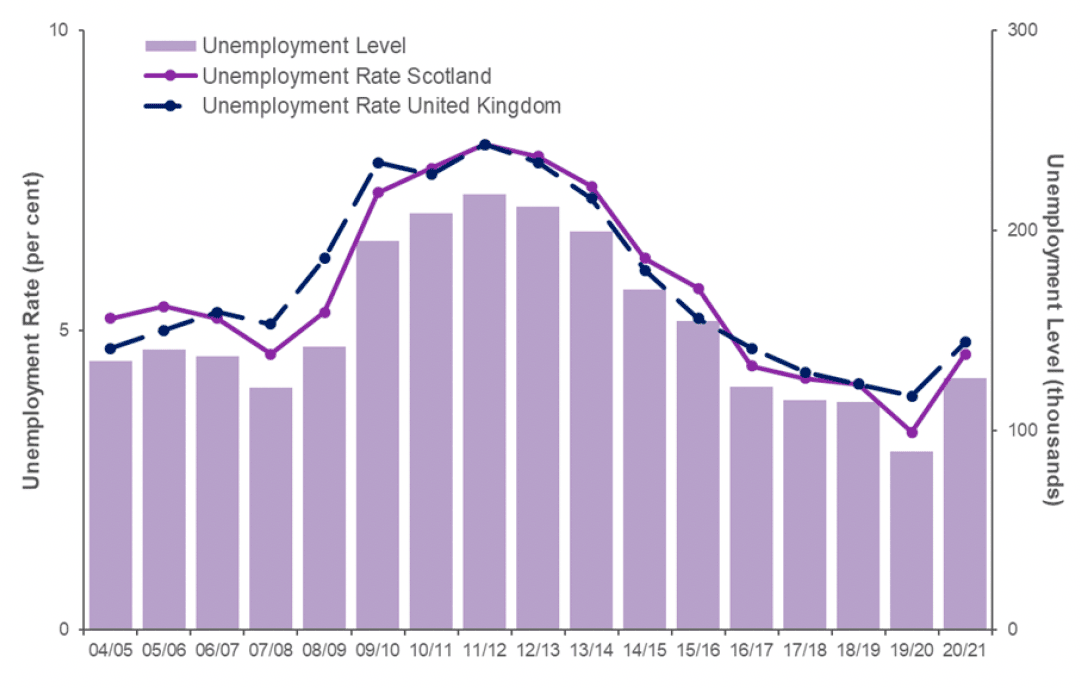
Source: Annual Population Survey, April-March datasets, ONS
Scotland's unemployment level and rate increased over the past year from a record low.
The unemployment rate in Scotland in April 2020-March 2021 was 4.6 per cent, below the UK rate of 4.8 per cent.
Over the year, the rate has increased in Scotland (a statistically significant increase of 1.4 percentage points) and also in the UK (a statistically significant increase of 1.0 percentage points).
Since April 2010-March 2011, Scotland's unemployment rate has significantly decreased by 3.1 percentage points, while the UK's unemployment rate significantly decreased by 2.8 percentage points.
There were 126,000 people aged 16 and over who were unemployed in Scotland, an increase of 36,700 over the year.
The peak unemployment rate, following the last recession, was in April 2011-March 2012 when the unemployment rate was 8.1 per cent and 218,300 people aged 16 and over were unemployed. This was 92,300 more unemployed people than in April 2020-March 2021.
4.2 Local Authorities
Model Based Unemployment (MBU) Rates[7] have increased in all 32 of Scotland's local authorities since April 2019-March 2020.
The highest MBU rates were seen in:
- North Ayrshire (5.8 per cent);
- North Lanarkshire (5.7 per cent); and,
- Glasgow City (5.6 per cent).
The lowest rates were seen in:
- Orkney Islands (3.1 per cent);
- Shetland Islands (3.3 per cent);
- Aberdeenshire (3.6 per cent).
Since April 2019-March 2020, MBU rates increased in all 32 local authority areas.
The largest statistically significant increases between April 2019-March 2020 and April 2020-March 2021 were seen in:
- Aberdeen City (up 2.2 percentage points from 2.5 per cent to 4.7 per cent);
- Angus (up 2.1 percentage points from 2.6 per cent to 4.7 per cent);
- Dumfries and Galloway (up 2.0 percentage points from 2.7 per cent to 4.7 per cent); and
- Perth and Kinross (up 2.0 percentage points from 2.3 per cent to 4.3 per cent).
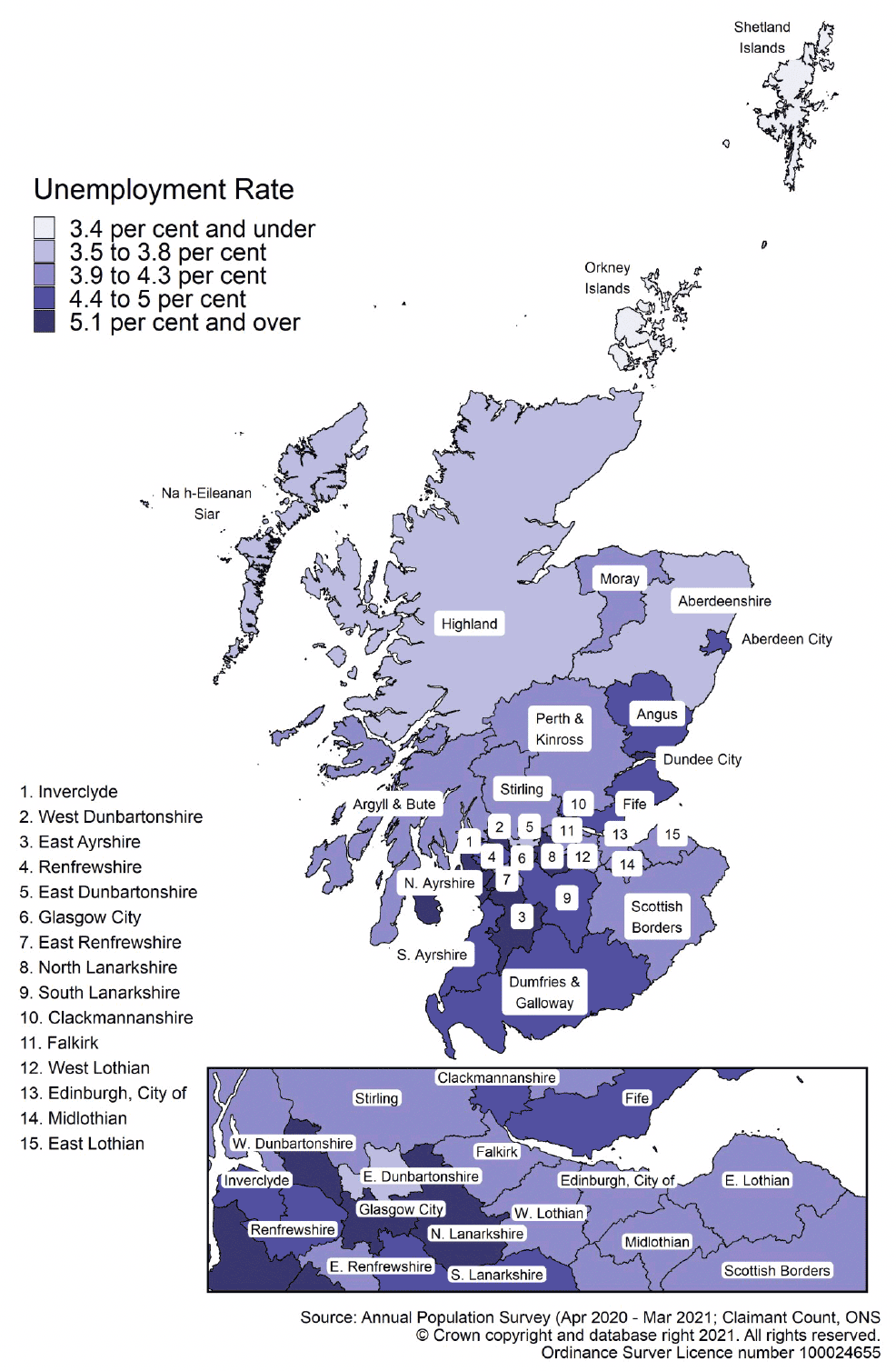
4.3 Sex and age
The unemployment (16 and over) rate has increased more for men than women in Scotland.
Since April 2019-March 2020, the unemployment (16 and over) rate for women in Scotland increased by a statistically significant 1.0 percentage points from 3.1 per cent to 4.1 per cent in April 2020-March 2021, while the unemployment rate for men increased from 3.4 per cent to 5.1 per cent (a statistically significant 1.8 percentage point increase) over the same period.
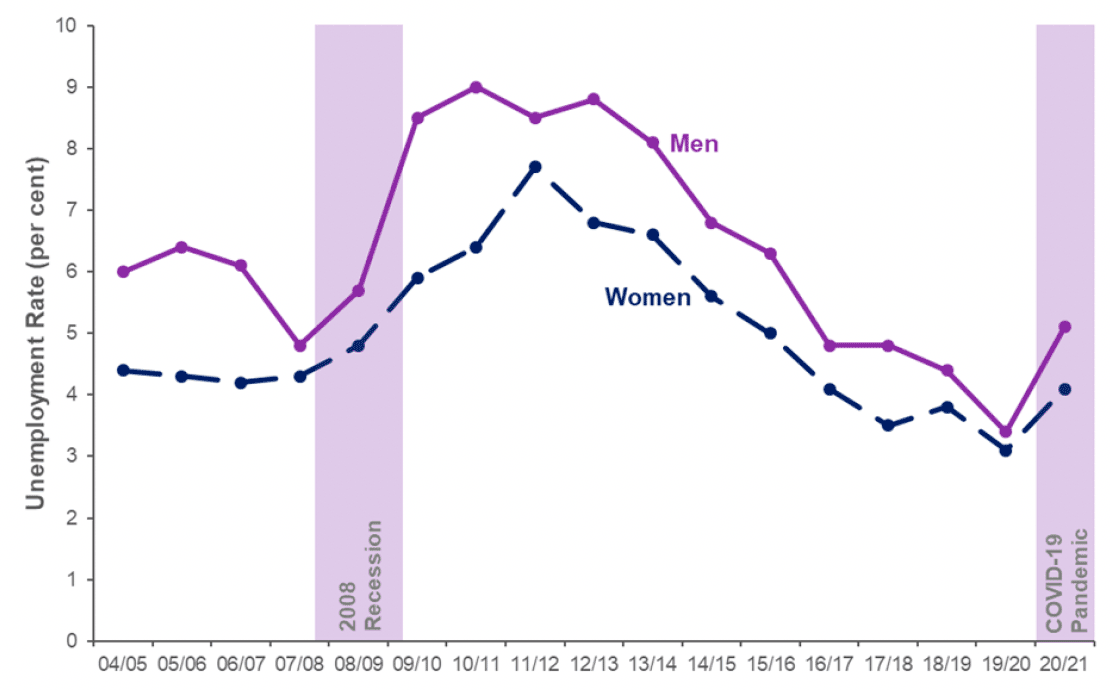
Source: Annual Population Survey, April-March datasets, ONS
Young people (16 to 24 year olds) in Scotland experienced the largest increase in unemployment rate, increasing by 3.6 percentage points, a statistically significant change over the year to 12.5 per cent in April 2020-March 2021.
The unemployment rate for those aged 16-24 in Scotland is the highest of all age groups at 12.5 per cent.
In April 2020-March 2021, there were 41,800 unemployed young people. This compares with 30,100 in April 2019-March 2020 and 92,400 in April 2011-March 2012, the peak of the series.
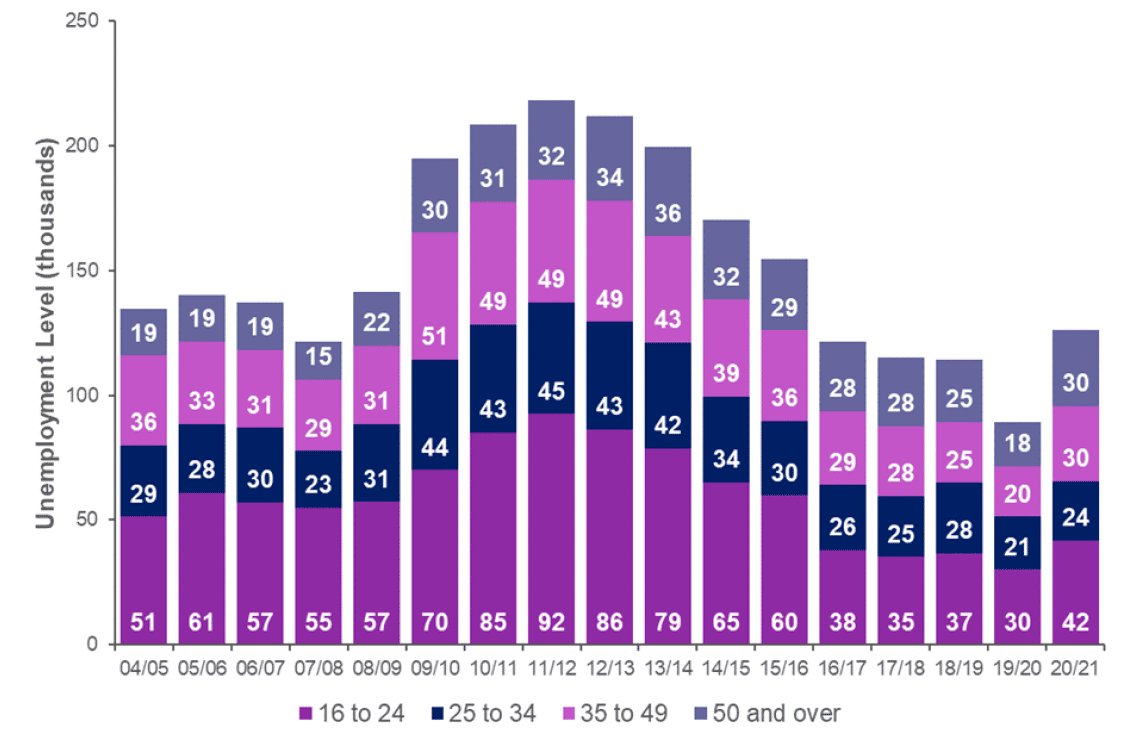
Source: Annual Population Survey, April-March datasets, ONS
4.4 Not in Employment, Education or Training
Estimates marked with an * indicate they are based on small sample sizes which may be less precise and should be used with caution.
12.4 per cent of people aged 16 to 24 years were not in employment, education or training (NEET) in April 2020-March 2021, an increase of 1.9 percentage points from April 2019-March 2020 but a statistically significant decrease of 4.4 percentage points from 16.8 per cent in April 2010-March 2011 (the peak following the recession).
The percentage of 16 to 24 year olds who are not in employment, education or training has typically been higher for women than men, particularly in the years to April 2014 to March 2015. However, the percentage of men not in employment, education or training was 14.4 per cent in April 2020-March 2021, higher than women at 10.4* per cent.
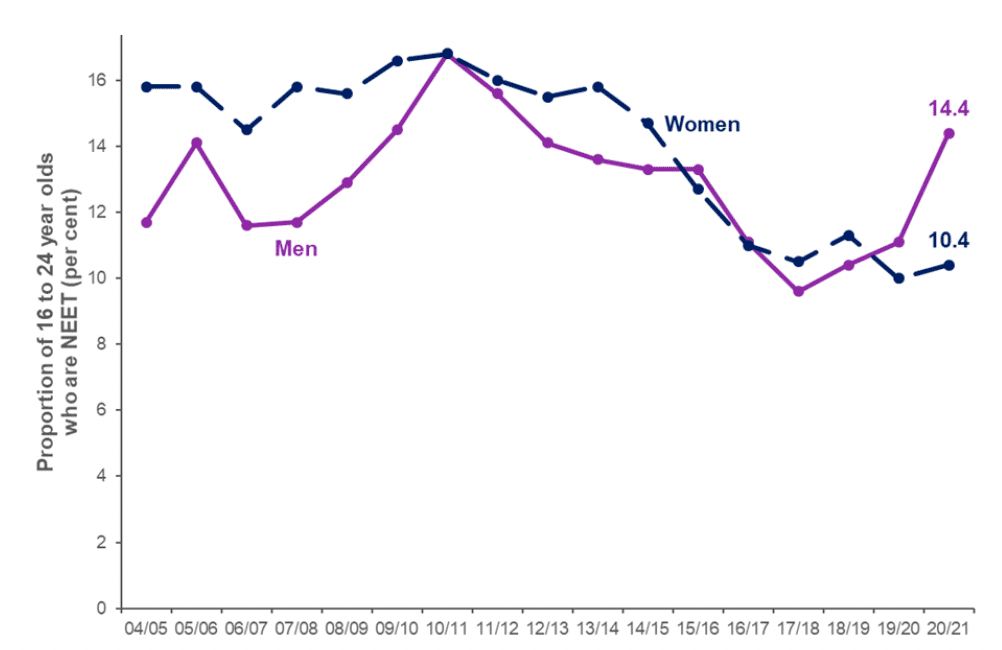
Source: Annual Population Survey, April-March datasets, ONS
4.5 Duration
41.2 per cent of all unemployed people (16 and over) in Scotland have been unemployed for 6 months or more
Of the 126,000 unemployed people in Scotland in April 2020-March 2021, 73,800 (58.8 per cent) were unemployed for less than six months (short-term unemployment).
This proportion is lower than in April 2019-March 2020 when 60.0 per cent of unemployed people were unemployed for less than six months. In the last year there has been an increase in the percentage unemployed for 6-12 months, which reflects the duration since the onset of the pandemic and initial flow into unemployment status.
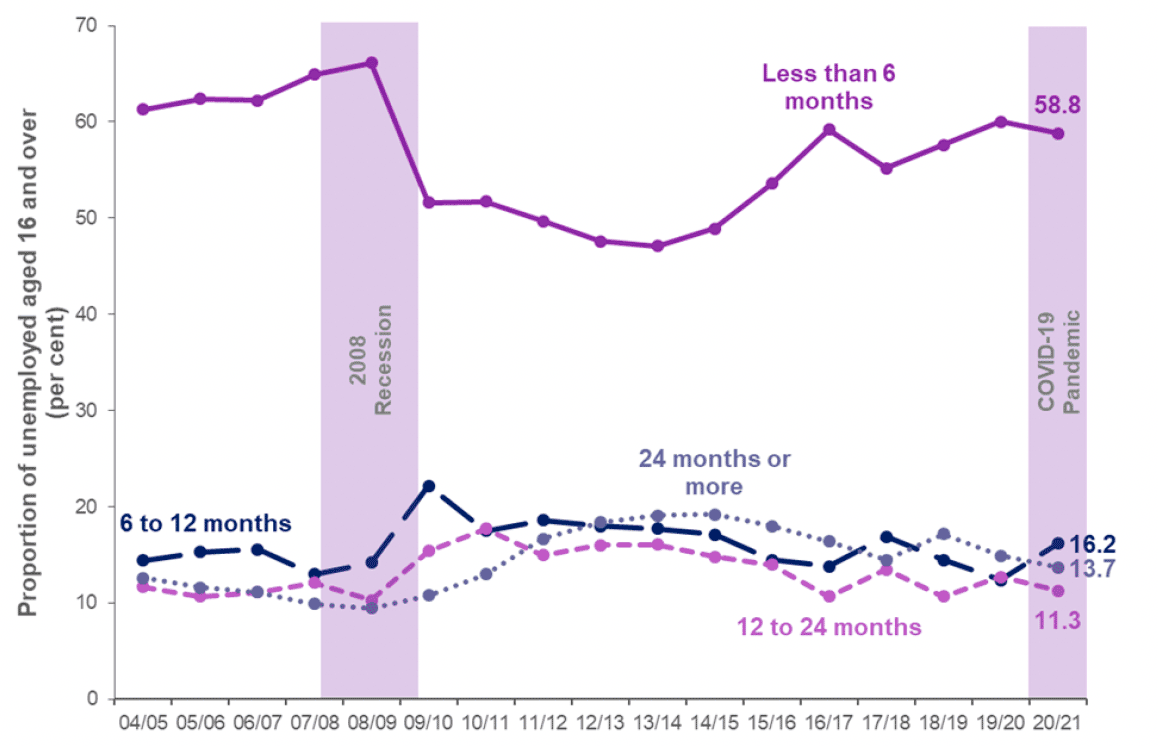
Source: Annual Population Survey, April-March datasets, ONS
In April 2020-March 2021, 31,500 (25.0 per cent of all unemployed people) were unemployed for 12 months or more (long-term unemployment), 6,800 more than in April 2019-March 2020 (24,700), however it remains at similar levels to April 2018-March 2019.
A higher proportion of unemployed men were in long-term unemployment in April 2020-March 2021 (26.0 per cent) compared to women (23.8 per cent). Men account for around three in five of all long-term unemployed.
The proportion of unemployed people who were long-term unemployed increases with age. In April 2020-March 2021, there were 9,600 unemployed people aged 50 and over who were unemployed for 12 months or more (31.8 per cent of all unemployed people aged 50 and over).
Contact
Email: lmstats@gov.scot
There is a problem
Thanks for your feedback